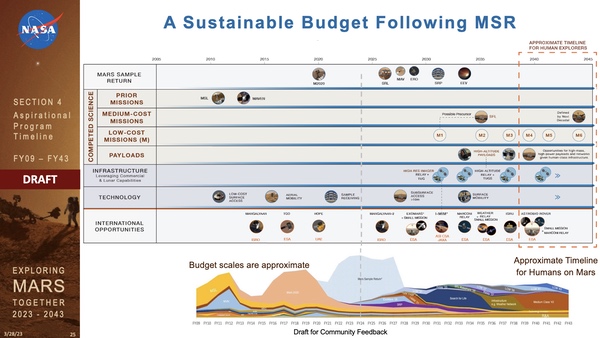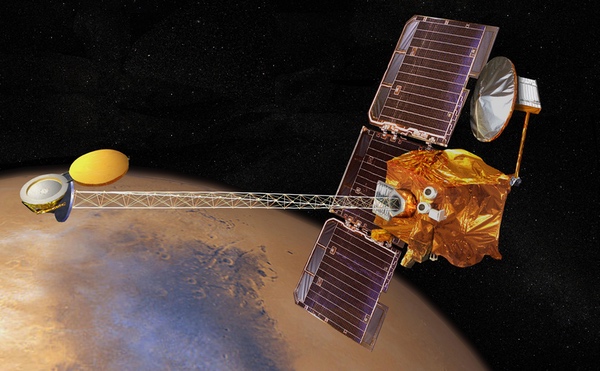Robotic Mars exploration after sample returnby Jeff Foust
|
| “We wanted to look two decades into the future as far as what are the things that we can do to create equally dramatic and profound science” as MSR, Ianson said. |
There was, for a time, an orbiter mission in development called the International Mars Ice Mapper, or I-MIM. But in last year, NASA elected not to fund development of it, after rounding up partnerships from Canada, Italy, and Japan to provide elements of the orbiter. The agency said last year that cost growth on Mars Sample return kept the agency from funding its share of I-MIM, but encouraged the other partners to proceed on their own (see “The future of Mars science missions”, The Space Review, May 9, 2022).
Lori Glaze, director of NASA’s planetary science vision, said at an LPSC town hall that NASA met with its international partners on I-MIM late last year, leaving the door open for the agency getting back into the mission. Those discussions, she said, “have honed and refined the mission concept into something that looks like something we might have an easier time participating in.” But she added, “we’re not making financial commitments right now.”
Eric Ianson, director of the Mars Exploration Program at NASA headquarters, said at the town hall that if NASA were to contribute, funding wouldn’t be needed until around 2026. In the meantime, he said NASA was collaborating with the partners “on the potential for what a partnership would like.”
The concern about a lack of missions extends beyond science. Several Mars orbiters are tasked with serving as communications relays in addition to their science missions, notably Mars Odyssey, Mars Reconnaissance Orbiter, and MAVEN. But the youngest of them, MAVEN, has been at Mars for nearly a decade; Mars Odyssey has been there more than two decades.
Last week, NASA offered its first glimpse of what the future of robotic Mars exploration after Mars Sample Return will look like. Speaking at a meeting of a committee of the National Academies’ Space Studies Board, Ianson rolled out a draft strategy for robotic missions extending into the 2040s, by which time NASA foresees astronauts landing on the Red Planet.
“We wanted to look two decades into the future as far as what are the things that we can do to create equally dramatic and profound science” as MSR, he said.
The “Exploring Mars Together” strategy does not outline a specific set of missions, but rather the types of science those missions would do and how they would be structured. Notably, after the multibillion-dollar Mars Sample Return effort, the strategy looks on what can be done on the cheap.
“What we’re proposing to do here is to do it at lower cost and a higher cadence of missions,” he said, avoiding the “peaks and valleys” of past Mars exploration efforts. “We want to try and maintain missions on a regular cadence.”
One line of the strategy is that regular cadence of missions starting as soon as 2030, the first window after the scheduled launch of MSR’s Sample Retrieval Lander. Ianson suggested a line of missions flying in every launch window, with NASA spending on the order of $300 million at each opportunity.
That could be, he said, a single $300 million mission, three $100 missions, or something in between. “It provides a good opportunity for the proposing community to get really creative,” he said.
| “We think there’s going to be an opportunity in advance of humans getting to Mars where we can do things that will help inform human exploration,” Ianson said. |
The idea of such low-cost had been endorsed by previous studies, one by the Mars Architecture Strategy Working Group (MASWG) and another by a committee organized by Caltech’s Keck Institute for Space Studies. Both concluded that low-cost Mars missions could be carried out and perform useful science (see “A FAB approach to Mars exploration”, The Space Review, March 7, 2022.)
That included missions with costs between $100 million and $300 million. “We think missions in this range have the potential to do outstanding science,” Bruce Jakosky, who chaired the MASWG study, said at a workshop a year ago about low-cost Mars missions.
Ianson said that the steady cadence of low-cost missions would be augmented by occasional larger missions. He described them as similar to the New Frontiers line of medium-class planetary science missions, with costs of at least $1 billion.
The first might be a version of Mars Life Explorer, a mission recommended in last year’s planetary science decadal survey. It was designed as a lander to examine subsurface ice deposits, using a drill that would collect samples from up to two meters below the surface, studying them for biosignatures. The decadal projected Mars Life Explorer launching in the latter half of the 2030s; Ianson’s charts included an “aspirational” timeline that featured a “Search for Life” mission launching around 2035.
A third line of missions in the strategy are payloads that would fly as “missions of opportunity,” he said. That would involve instruments going on international missions as well as potentially commercial missions.
And what would those missions do? Ianson described three broad themes for the science the three classes of Mars missions would perform. One would be to continue the search for past or even present life on Mars. That could include looking for biosignatures as well as “patterns of habitability” on the planet.
The second would be to support NASA’s plans for human Mars missions, with the first notionally planned around 2040, a date NASA administrator Bill Nelson reaffirmed in an appearance at Axios’s “What’s Next” event the same day Ianson spoke at the National Academies.
“I’m saying 2040,” Nelson said when asked about comments earlier in the event by former astronaut Sen. Mark Kelly (D-AZ), who predicted humans on Mars in 20 years.
“We think there’s going to be an opportunity in advance of humans getting to Mars where we can do things that will help inform human exploration,” Ianson said. That would include characterizing ice deposits that could be resources for future human missions as well as studying health and safety hazards.
A third theme, called “Discover Dynamic Mars,” would cover other science topics. He said that might involve studies of the planet’s geology and climate to see how the planet evolved from its initial warm, wet conditions to its current states, and to support work in comparative planetology.
 A chart from the presentation that shows a notional timeline and budget for the new Mars exploration strategy (larger version) |
The strategy is more than about science, though. Ianson said another element of the plan is to refresh that aging infrastructure, such as communications as well as the high-resolution imaging that Mars Reconnaissance Orbiter provides. That infrastructure could also include monitoring Martian weather. The aspirational timeline he presented featured a mission to serve as a communications relay and with a high-resolution camera launching in the early 2030s.
Both the low-cost science missions and the infrastructure missions would provide opportunities for commercial partnerships. Ianson said the science missions might leverage lessons learned from such efforts as Commercial Lunar Payload Services, where NASA buys payload space on commercial lunar landers that also carry payloads for other government and commercial customers.
| A notional budget chart showed spending holding steady through the 2030s at about half of current spending on Mars exploration. |
“That’s one of the things that we’re going to explore: how do we find these win-win solutions where we can get science but it’s also benefiting the things that they’re looking to do,” he said of such partnerships. “There is no shortage of companies that have interest. The real question is, do they have the capability to be able to do that job?”
What’s also unclear is the budget for this. Ianson noted in the presentation there is no budget yet for this draft strategy. A line in the fiscal year 2024 budget proposal for “Mars Future Missions,” which grows from $50 million in 2024 to a projected $177.4 million in 2028, is intended to fund work on a sample receiving facility for samples returned by the MSR missions as well as NASA’s contributions to the ESA’s ExoMars rover mission, Rosalind Franklin, after ESA cut off cooperation with Russia on that mission last year.
He did not provide any estimates for budgets but did display a notional “sand chart” budget of overall spending on past and projected Mars programs by stacking one mission on top of the next. That chart showed spending holding steady through the 2030s at about half of current spending. NASA’s fiscal year 2024 budget proposal requested about $1.2 billion for Mars exploration, $950 million of that for MSR.
The draft strategy is just that: a draft that NASA is soliciting feedback on over the coming months. That includes discussions about it at next week’s meeting of the Mars Exploration Program Analysis Group, an advisory committee for Mars exploration.
“Following the launch of MSR, we want to implement a sustainable portfolio” of missions, he concluded. “The content and the schedule are variables to be managed against a sustained budget level.” Now, there are at least outlines of what kind of missions can be developed, if there is a budget to manage them.
Note: we are using a new commenting system, which may require you to create a new account.
